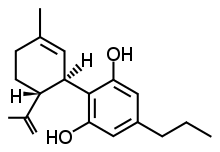Cannabidivarin
Cannabidivarin (CBDV) is a non-psychoactive cannabinoid found in Cannabis. It is a homolog of cannabidiol (CBD), with the side-chain shortened by two methylene bridges (CH2 units). Plants with relatively high levels of CBDV have been reported in feral populations of C. indica ( = C. sativa ssp. indica var. kafiristanica) from northwest India, and in hashish from Nepal.[1][2] CBDV has anticonvulsant effects.[3] It was identified for the first time in 1969 by Vollner et al.[4]
 | |
 | |
| Clinical data | |
|---|---|
| ATC code |
|
| Identifiers | |
IUPAC name
| |
| CAS Number | |
| DrugBank | |
| ChemSpider | |
| ECHA InfoCard | 100.236.933 |
| Chemical and physical data | |
| Formula | C19H26O2 |
| Molar mass | 286.41 g/mol g·mol−1 |
| 3D model (JSmol) | |
SMILES
| |
InChI
| |
| | |
Similarly to CBD, it has seven double bond isomers and 30 stereoisomers (see: Cannabidiol#Double bond isomers and their stereoisomers). It is not scheduled by Convention on Psychotropic Substances. It is being actively developed by GW Pharmaceuticals (as GWP42006)[5] because of a demonstrated neurochemical pathway for previously-observed anti-epileptic and anti-convulsive action.[6] GW has begun a phase 2 trial for adult epilepsy,[7] and is to begin trials of this CBDV product in children in 2016 in Australia.[8][9]
See also
References
- Turner CE, Cheng PC, Lewis GS, Russell MH, Sharma GK (1979). "Constituents of Cannabis sativa XV: Botanical and chemical profile of Indian variants". Planta Medica. 37 (3): 217–25. doi:10.1055/s-0028-1097331.
- Hillig KW, Mahlberg PG (2004). "A chemotaxonomic analysis of cannabinoid variation in Cannabis (Cannabaceae)". American Journal of Botany. 91 (6): 966–75. doi:10.3732/ajb.91.6.966. PMID 21653452.
- Hill AJ, Mercier MS, Hill TD, Glyn SE, Jones NA, Yamasaki Y, Futamura T, Duncan M, Stott CG, Stephens GJ, Williams CM, Whalley BJ (2012). "Cannabidivarin is anticonvulsant in mouse and rat". British Journal of Pharmacology. 167 (8): 1629–42. doi:10.1111/j.1476-5381.2012.02207.x. PMC 3525866. PMID 22970845.
- Vollner, L.; Bieniek, D.; Korte, F. (1969-01-01). "Haschisch XX11XIX. Mitteillung: F. von Spulak, U. Claussen, H.-W. Fehlhaber und F. Korte, Tetrahedron 24, 5379 (1968).: Cannabidivarin, ein neuer Haschisch-Inhaltsstoff". Tetrahedron Letters. 10 (3): 145–147. doi:10.1016/S0040-4039(01)87494-3. ISSN 0040-4039. PMID 5778489.
- "GW Pharmaceuticals Announces Preliminary Results of Phase 2a Study for its Pipeline Compound GWP42006". GW Pharmaceuticals. 21 February 2018. Retrieved 28 May 2019.
- Amada N, Yamasaki Y, Williams CM, Whalley BJ (2013). "Cannabidivarin (CBDV) suppresses pentylenetetrazole (PTZ)-induced increases in epilepsy-related gene expression". PeerJ. 1: e214. doi:10.7717/peerj.214. PMC 3840466. PMID 24282673.
- "GW Pharmaceuticals Initiates Phase 2 Clinical Study of Cannabidivarin (CBDV) in Epilepsy" (Press release). GW Pharmaceuticals. May 6, 2015. Retrieved November 10, 2015.
- "GW Pharma Press release". Archived from the original on 2015-11-21.
- "NSW advice to practitioners on Medical Cannabis trials" (PDF). Archived from the original (PDF) on 2015-11-21.